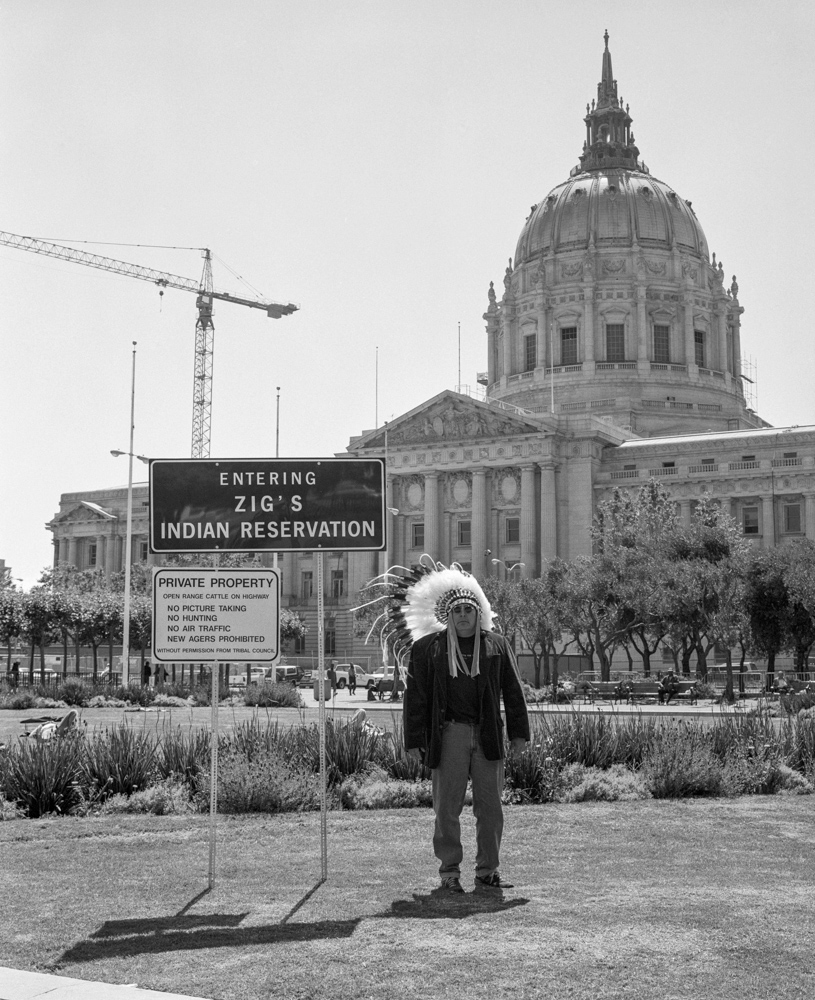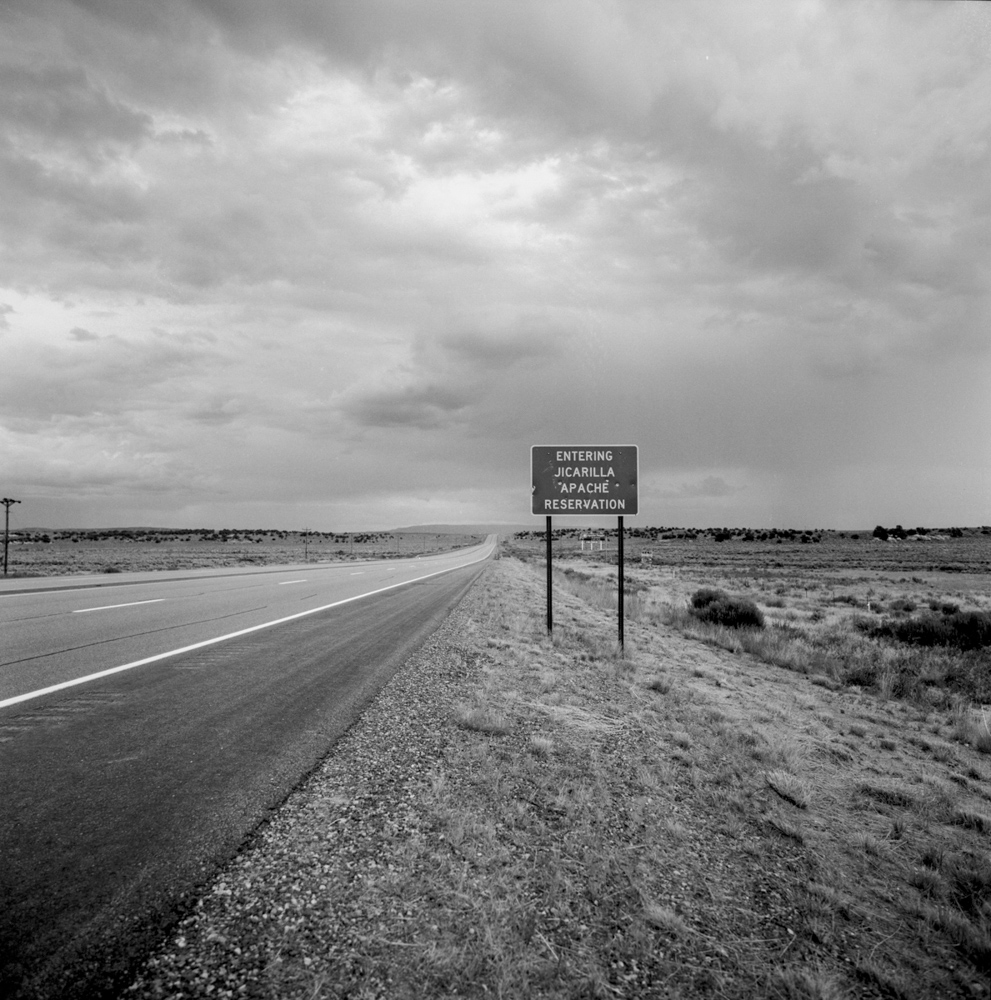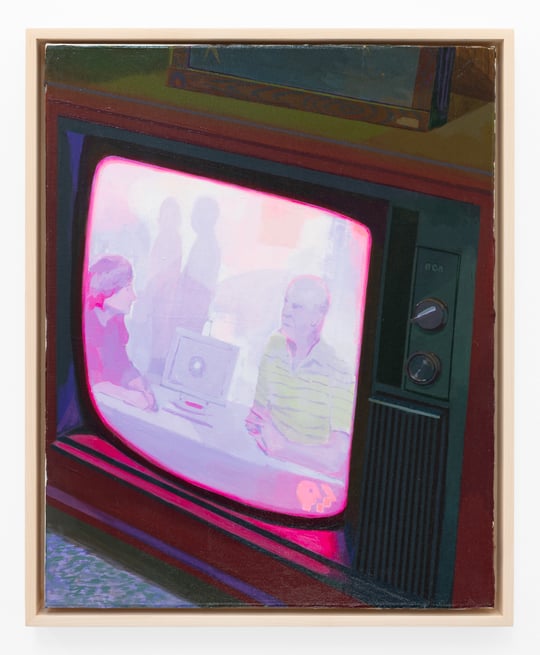
Zig Jackson, whose Indian name is Rising Buffalo, is the first ever Indigenous photographer to be awarded a Guggenheim, an award that is especially prized within the field of photography, having been awarded in the past to artists such as Walker Evans, Ansel Adams, Imogen Cunningham, Robert Frank, Diane Arbus, Uta Barth, Lewis Baltz, and William Christenberry, among others. Jackson was raised in North Dakota on the Fort Berthold Indian Reservation. When Jackson introduces himself, he often indicates that he is foremost an educator. The camera is his curriculum. Photo-based images teach us about who has been represented visually and how this circulates, challenges, or perpetuates meaning. His photographs offer a deconstruction of myths and offer a critique of art history’s tendencies to exoticize Indigenous peoples. They complicate territorial land claims and notions of occupation, setting up a dialog between the body – his own or the bodies of tourists or the bodies of other Indigenous persons – and land, property, signage, and signification. His work over the years blends a humbling, understated sense of performance art with the tainted sadness of the camera as it has “taken” photographs of Indigenous peoples since its invention circa 1830s. A professor at Savannah College of Art and Design in the Photography Department since 2000, Jackson is a member of the Mandan, Hidatsa, and Arikara Nation in North Dakota. He attended St. Joseph’s Indian School in Chamberlain, South Dakota, as a child and then Intermountain Indian School in Brigham City, Utah, where he first picked up a camera. With “an awareness of all Native American needs and problems—such as poverty, alcoholism, and suicide, [he realized] that all Indian people are confronted with the same obstacles.” Jackson’s work is represented in the Library of Congress, and he has been honored with numerous awards including The Beaumont Newhall Award for Photographic Excellence from the New Mexico Humanities Council. This interview was conducted in person and has been edited for publication.
Lisa Jaye Young: Zig, I’m honored to be able to talk with you about your work this summer and to be one of the first to congratulate you publicly on your honor this past Spring! The Minot Daily News in Minot, ND, mentioned in its announcement about your award that your plan is to do a book project with the fellowship. Can you share what you have planned?
Zig Jackson: My friend Gerard Baker called the Minot paper. He is a long-time friend and a Mandan-Hidatsa tribal member as well. We went to Catholic school together, and he became National Park Service superintendent, working at Mt. Rushmore. He just called the Minot paper out in the middle of North Dakota. I told him that I want to do a book and a show at the Guggenheim. I kept applying for the Guggenheim every year, and I wept when I was notified that I was selected as a fellow. So the book will be like a retrospective. I’m working with the Andrew Smith Gallery now in Tucson. It will be my first book! Lucy Lippard agreed a long time ago, so she will write the foreword. I’m heading out West, which I do every summer, with my family – going to Pawnees and Poncas and visiting with many other tribes, continuing with the Indian Home series. One summer I went to as many western United States Indian reservations as I could. Sometimes I go and don’t even take pictures, and I visit with the tribal peoples.
LJY: The Guggenheim is an opportunity to propel your work and to raise awareness for more audiences about the inequities faced by Indigenous populations, a conversation that is ridiculously overdue on so many levels. We are reading so much lately about the atrocities against Indigenous populations in Canada and the U.S. then and now in terms of land appropriation, education, and infrastructural inequities. What does this award mean for you in this context?
How can one own the wind?
ZJ: I was a product of all of that at St. Joe’s Indian School and then at Intermountain Indian School. I am a product of the Indian school programs. I want everyone to know that I went to Intermountain. Every type of tribal Indian was at that school. Wow. I can go to just about every reservation and I’ll know someone. I feel a part of it because I’ve experienced it. St. Joe’s had us put rosaries in envelopes – 20 rosaries and you’d get a free candy bar. They taught us trades instead of academics: carpentry and auto body mechanics for the boys and home economics for the girls. When you see a little kid like that grow up and get an award like the Guggenheim, it’s an amazing thing. I was the first Native American to get a master’s degree in Photography and to graduate from the San Francisco Art Institute. The first to have my photography represented in the Library of Congress. The first to achieve a Guggenheim for photography. Winning this is for all of those kids. It’s for every one of them.
LJY: And so that the readers have a sense of context, can you talk about your most prominent works from the Entering Zig’s Indian Reservation series in which you pose in front of City Hall in San Francisco, a bus station on Mission Street, and other locations with the sign “Zig’s Indian Reservation” and with a second sign that reads: “No Picture-taking, No Hunting, No Air Traffic, and New Agers prohibited.” The images expose the land, the interventions and destruction within it. How did this series come about and how did you choose your locations?
ZJ: Every year, during summer vacations, I would live in my VW van and go to Indian tribal reservations and think and take pictures and visit with tribal peoples. The series came out of that. I began to wonder: why can’t I be my own Indian?; why can’t I be my own medicine man?; why can’t I have my own reservation? In the 1960s-1980s the government implemented a relocation program. They would take Indians off of the reservations and put them into major urban areas. It was a divide-and-conquer technique. They would take us off reservations and put us in Indianapolis and Chicago and Denver, Pittsburgh and Cleveland and the Bay Area, but we didn’t forget our way of life. It just made us stronger. I went to the San Francisco Art Institute, where performance art was prevalent. “Entering Zig’s Indian Reservation” was a kind of performance piece. Sitting in Golden Gate Park with William Randolph Hearst’s buffalo. Going out into the streets or standing on the highway and reclaiming that land as ours. When I take photographs, I want to express thanks to the land, and so I place some tobacco down to say I’m honored to be there. I give respect to the tribal California Indians. You can feel that energy.
LJY: On the topic of “Zig’s Indian Reservation,” you have written that you are “here, occupying these different areas,” almost as an alternative to traveling to existing reservations. And, of course ALL American land is formerly Native Peoples’ land. What does the term “occupation” mean to you in your work?
ZJ: How can one own a tree? Or how can one own the wind? It’s for everybody. You just give thanks. You listen to the elders. When I did my first vision quest, I was 19 years old. This was a time when I had to make a decision about staying or going. I took my sleeping bag and the wind was blowing, and everything came back to me: the knowledge, the grass rubbing on itself, a Red-tailed Hawk—I heard him fluttering and I saw all of the deer coming out. My senses came back to me. It’s about the experience. How can you own or occupy that?

LJY: Legacy, family, children, education. These things seem to be very important to you. Can you say more about these topics in your experience and your work?
ZJ: I’m the 7th out of 10 kids. A Catholic family with 5 girls and 5 boys. I’m the only one who left. My Dad was a veteran of the Korean War and a spree alcoholic. He told me to leave. My Dad always told me to leave the reservation. He would say “beat the white man at his own game. Get an education.” And so I left. I’m sure that if he were alive, he’d be proud of me for getting this award. Now I teach kids to go out and get culture. I teach all kinds of kids. I teach them what I know. I also take my own sons with me. This summer we’re going out to find the Scissor-tailed Flycatcher, the state bird of Oklahoma.
LJY: Following up on your answer, and as a fellow professor, I admire your statement that you’re an educator first and foremost. That the role of the photograph is also to educate. How do you interweave your own practice and your teaching?
ZJ: Photography and education go as one. I lecture at colleges and institutions and teach about the tribal peoples through my photos. I travel to smaller colleges or wealthy colleges. It doesn’t matter. They are all one. That’s what it’s all about. As long as it’s educational, and you’re teaching something good, then it’s ok. I’m an educator. That’s what my photographs do. I want them to teach. That’s the most powerful thing. That eye of the camera – how we see the world. There’s power in that. That damn little IPhone is very powerful, and we need to be aware of its power. Now everybody’s a photographer.

LJY: In your Indian Photographing Tourist Photographing Indian series, the element of sadness is very present. I think of other photographers photographing tourists, like one of your own teachers, Patrick Nagatani, and the notion of “disaster tourism” that some of his work confronts. Or a fellow Guggenheim recipient, Gary Winogrand, and his exposure of the mechanism of tourism. Living in Savannah, we see the complicated way that tourism transforms a place. What role does the act of tourism play in your work?
ZJ: In my life, tourism was a part of our culture. Every year an “-ologist” would come, psychologists, anthropologists. We used to call them “-ologists.” We would say, “Which ‘-ologist’ is coming today?” They would come to study us and to take pictures of us. “Let’s see how long these Indians can run,” they’d want to know, and then they’d start a running program. It has an impact. But now I take pictures of them taking pictures of us. I’ll sit there and watch it unfold and take pictures. That’s the way this culture has been treated all this time. The photographer Edward S. Curtis started it. When he photographed the American Indians, he stereotyped us. He made us noble and stoic, which is sad. Every figure is stoic and not smiling. Hollywood also took over on this and the stereotype carries on. But we love to tease and laugh. This stereotype is false. In fact, the Crows have a teasing clan. They use teasing and laughing to help you to grow. The stuff you see in my work comes from tradition and culture. It all comes from things I grew up with.
LJY: Many of your images are composed as a direct address to the camera. But they seem less about interrogation and more of an assertion of your role as very present – here and now, maybe even as a witness. Do you think of the camera as a witness?
ZJ: I think of the photograph as a “happening.” It is a spur of the moment act. It is a happening that was supposed to happen. Not a confrontation. Indian Man in San Francisco, for instance. It’s to tell a story about this guy looking for his culture. Miwok, Sauk, Shoshone, Pawnee, any of them. You seek your culture. You say I’m here to photograph. It solidifies. Just because you have a camera doesn’t mean you have the right to shove it in someone’s face. You must have respect with the camera. At the turn of the century, many of the old Indians said that the photographers would steal one’s soul. It’s true. I have to prepare to take photographs. It takes me months to get ready to photograph like this: thinking, organizing, cleaning, thinking some more, preparing. Photography is sacred.
LJY: Thank you, Zig. There is so much more to discuss, and I am looking forward to seeing your project unfold. For now, one more question: you’ve lived in Georgia for over two decades, how has the American South influenced your work and practice?
ZJ: Indian Man in the South. The photograph that I call “Take a Picture with the Indian” from my Degradation series was taken in South Carolina. All of the tribes of the Southeast have broadened my mind. From the Carolinas to Florida, from Georgia to Tennessee, I see all the differences: Creeks, Choctaws, Cherokees, Shawnees, Seminoles… This is where I am supposed to be at this time in my life. This is a beautiful place. This land used to have trees from Maine to Florida, where a squirrel didn’t even have to touch the ground. Look at the Crepe Myrtle tree, for instance. I tell my students that you have to know what you’re shooting. They need to know where they are. That’s what photography teaches you. I’ll tell them to shoot the MLK Parade in Savannah, shoot the hearse driving by. That teaches them to have diversity in their photography. You’ve got to have culture in your photography. You’re supposed to be having a conversation with this place. That will make your art strong. I’m content here. So what if I don’t make a big piece that will sell for 10k—it’s a beautiful place. I tell students to go photograph The Majestic Oak or the smallest house in America. They’re here in Savannah. So, I tell them to photograph where they are. To appreciate where they are. To find out why they are here.




